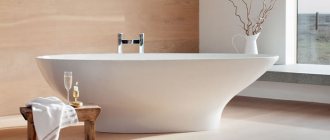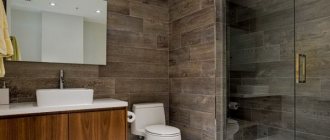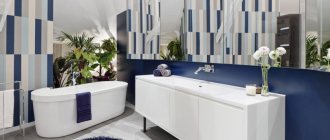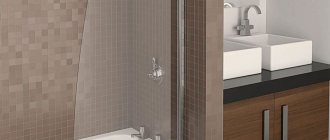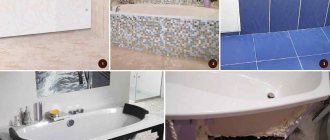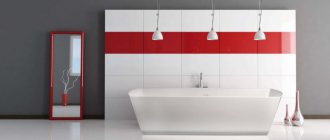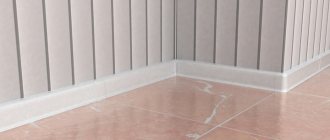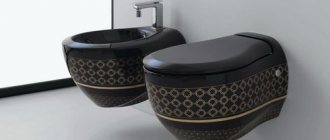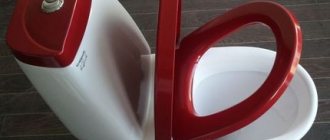When starting to choose a corner bathtub, many are lost in their diversity, and many wonder whether it is worth purchasing such a product at all, especially if we are talking about a small space. After reading this article, no one will have any questions about the choice and important nuances associated with corner baths.
Corner baths were specially designed for small bathrooms
Corner models - rational use of space
Indeed, a corner bath in a small bathroom can help make efficient use of one of the free corners. Using them correctly can be quite difficult, but a corner product can easily help solve this problem. We suggest looking at photos of corner bathtubs in small bathrooms to make sure that when choosing such a model, you can use the space efficiently.
The compact location of the bath in the corner of the room allows you to increase the usable area
Corner bath in a small bathroom
A common option for such layouts is where the bathroom is combined and its area is approximately 3.5 square meters. The dimensions of such a room are 2.2 * 1.6 m. The short side is usually used to install a bathtub. This placement option is quite compact and allows you to accommodate other important plumbing elements: toilet, sink, and so on.
Compact corner bathtub is an excellent solution for a small bathroom in Khrushchev
Tape variations
If you need to instantly and cost-effectively remove gaps between your bathtub and a wall or sink and give the room a great look, then curb tape is great for this.
But do not forget that this curb will serve you no more than 2 years, and therefore this option can only be analyzed as short-term. Such tapes have a thickness of about 2 mm and are available in different widths. High-quality curb tape has excellent performance properties.
It is made from polyethylene or elastomer. One side of it is covered with butyl glue. Many border tapes contain fungicides that protect the bathroom from the formation of fungi and mold. This border is completely waterproof, will not crack, is easy to use, and thanks to its plasticity, it can be bent at any angle.
Features of installation work
Of course, first of all you need to purchase a border strip of the required width. In order not to make a mistake, measure the largest width of the gap between the wall and the bathroom. And now, the tape has been purchased, where to start, how to stick the border on the bathtub? Let's consider all the work steps and their distinctive characteristics.
- You should carefully prepare the surface on which the tape will be glued. It must be cleaned of dirt and grease. You can use cleaning products and soda for this purpose. For degreasing, you can use gasoline or alcohol. If you are gluing the border a second time, then make sure that there is no old glue left on the surface of the wall and the bathroom. The surface must be completely clean and dry.
- If the cracks are wide enough, it is better to carry out preparatory sealing. Silicone-based sealant for acrylic bathtubs is excellent for this.
- When the silicone is completely dry, we begin gluing the border. As a rule, you can get by with the glue that is applied to the tape itself. To do this, you need to heat it with a repair hairdryer. But, this glue is not considered very durable. Also, when heated, the tape stretches somewhat, and when it cools down, it begins to shrink, which leads to its peeling off from the wall. And therefore it is better to use liquid nails for this. At this step, you need to stock up on this “miracle glue” and a gun for applying it to the planes.
- Then you need to prepare pieces of tape of the required length. Plus, you need to remember that this length must be a couple of cm longer than the length of the plot on which it will be glued. Apply a thin layer of glue to the base of the tape and press it against the bathtub, and the other edge against the wall. It is better to start gluing from the corner, slowly removing the film in small pieces. Since the quality of the entire work depends on the pressing force, it is better to perform it with an assistant. Each area must be pressed for 20-30 seconds.
- After finishing the work, it is necessary to seal the joints at the corners, and for 24 hours do not allow water to penetrate the curb.
If you follow everything exactly, you will get a beautiful look for your bathtub.
Installation
Installing a bathtub with your own hands is a very responsible task, and therefore we suggest learning several useful subtleties of this matter.
- When installing a hot tub, you must provide a grounded outlet.
- When the bathtub is installed strictly horizontally, but the bottom seems slightly inclined, this is absolutely normal. This will ensure rapid drainage of water.
- Before installing it yourself, you need to think about the drainage. A corrugated hose is best suited for this; with its help, installation is easy and operation will be reliable.
- To ensure that the installation does not disturb the overall design of the room, you need to think through decorative elements. If the manufacturer does not offer additional supports and bases, then you can use tiles for facing or a sliding panel.
Modern acrylic bathtubs are in most cases equipped with a special frame
Installation of such models comes down to assembling the frame and adjusting the height of the legs
How to glue a plastic, tape baseboard to a bathtub, installation methods
Not a single wall in a building, including the walls in the bathroom, is perfectly straight - not to mention modern buildings. Moreover, during construction it is impossible to achieve absolute parallelism of opposite walls. Therefore, when installing a bathtub, there is always some kind of gap, a gap between the sides of the bathtub and the walls of the room, and as a result, water leaks on the floor and even higher humidity in the room.
There are many ways to seal these cracks. Every apartment owner comes up with something based on the circumstances. You can seal the gap, for example, with cement or some other suitable building material. However, the durability of such a “design” remains in doubt. The best solution is to glue a special baseboard to the bathtub.
This product is called differently: baseboard, border, bathroom corner. There are three main types of such skirting boards: tape, plastic and ceramic. There are also VIPs (made of marble, etc.), but they are a separate discussion, since they are not widely used.
Therefore, for self-installation it is better to use tape or plastic skirting boards. However, there are some differences in their installation, so we will briefly talk about each type of skirting board.
Plastic skirting board
It is considered the most economical and easiest to install type of borders. On sale there are not only straight skirting boards that are easy to cut, but also various corners. Therefore, with the help of such skirting boards you can reliably “insulate” a bath of any size and configuration. To fasten the plastic, liquid nails and silicone glue are used. The entire installation comes down to the correct marking of the elements of the overall edging of the bathtub and gluing them. One side is towards the bathtub, the other is towards the wall. Moreover, you can glue it both on the tile and “under” it (on the wall). This kind of work can be done by anyone, even an inexperienced person. The main thing is to then thoroughly seal the joints of the plinth strips and corners with sealant. However, you need to take into account that over time the edges of the plastic may “lift” and it will begin to let moisture through. Therefore, it is better to lay wall tiles on top of the baseboard.
General measures for both types of skirting boards:
- prepare surfaces;
- Pre-seal the gap with sealant;
- After drying, apply liquid nails;
- press the plinth (tape) tightly;
- seal the joints;
- thoroughly dry the gluing areas.
Material of manufacture
- Cast iron. This is a traditional material for the manufacture of plumbing fixtures, as it is particularly strong, reliable and durable. Such a product will serve for at least 50 years. Of course, the enamel can crack, but this is very easy to fix. Cast iron bathtubs are also characterized by mechanical strength: thanks to a thickness of at least 8 mm, they are practically not afraid of impacts and damage. If we talk about thermal conductivity, the coefficient is so low that the water taken into the bath will maintain its temperature for an hour.
Cast iron bathtubs have proven themselves in terms of reliability, but the huge disadvantage of these products is their heavy weight
However, in most cases such bathtubs are manufactured to order. Prices for such models start from 60 thousand rubles.
A variant of the popular model is the Roca Continental. Length 1.7, width 0.7. Good for small rooms.
Cast iron bathtub Roca Continental from a Spanish manufacturer
The bottom is covered with an anti-slip coating, which helps prevent falls. The model is resistant to chemicals, which increases its service life.
The bathtub is installed using the legs that are included in the kit. The cost is approximately 67 thousand rubles.
- Acrylic. The most common today. The advantage of such models is their easy transportation, because they are light in weight. No special care required. The surface is smooth and non-porous, and therefore the dirt literally slides off the surface itself. The service life is approximately 10-15 years; in case of damage, the coating can be restored. One of the main disadvantages is low mechanical strength. In order for the bathtub to withstand heavy loads, it must be installed on a special frame or frame.
Despite the affordable price, acrylic bathtubs are of fairly high quality.
What are the benefits of corner-shaped borders?
In addition to its low cost, a plastic bathroom border has a number of advantages that often tip the scales in its favor.
Thus, there is no glue already applied to the baseboard, so you can choose the most suitable composition applicable specifically to your operating conditions. In this case, you will not have to scrape off the “native” glue, as often happens when using self-adhesive tape.
In addition, plastic bathroom borders in the form of a corner are very useful in cases where, as a result of installation, the gap between the wall and the edge of the washing container is quite wide.
A plinth made of self-adhesive tape is unlikely to close such a gap, and even if it is possible to cover the gap, then, most likely, such a border will come off quickly enough.
A plastic curb for a bathtub provides additional rigidity for fixing the bathtub, while it is practically not affected by vibrations and high humidity.
Corner bathroom - is it a good choice for a small room?
It is quite difficult to unequivocally answer the question of whether a corner bath is a good option for a small room. This option has disadvantages, and significant ones. Firstly, a large element placed in a small room creates a feeling of cramping and also adds inconvenience to the process of taking water procedures. Secondly, it becomes difficult to install anything else against the opposite wall. In general, not the most ergonomic option.
A corner bath saves space and leaves room for a sink and toilet if the bathroom is combined
Surface preparation and preliminary work
The technology for laying the border around the bathtub may be different, but preparation of the base is mandatory. You should clean the wall and edge of the bathtub with a good, high-quality detergent, then rinse with water and degrease. For the latter purpose, soda ash is used; if it is not available, regular soda or alcohol is used. Before gluing the baseboard, you need to make the surface dry. To do this, you can wipe the base with a lint-free cloth and dry it with a hairdryer. When you have to re-glue the headband, you must carefully scrape off the remnants of the old glue.
To glue the border, the following tools and materials may be useful (depending on the type of profiles, some will not be needed):
- glue or sealant;
- mounting gun;
- level, preferably laser;
- rubber spatula;
- sandpaper on a block;
- pliers;
- Bulgarian;
- roulette;
- construction tape;
- sharp knife;
- profiles of the required length.
Choosing a corner bath: review and recommendations
Before purchasing, be sure to study the characteristics of various materials.
- First you need to decide on the size of the model. It directly depends on the size of the bathroom. Accordingly, small corner baths are suitable for small spaces.
- Next is to choose the material. The most popular is acrylic. Often such models come with various additional features, for example, hydromassage. If there is a back massage function, then you need to make sure that the product has high power. The number and location of nozzles is important - there should be at least 12 of them.
- Design. The product should look good in the interior, not overload or stand out from it.
- If you plan to install curtains, then it is better to give preference to models with a set of curtains and a rod of the appropriate bend.
The size and shape of the bathtub are selected based on the dimensions of the bathroom
When choosing the size of the bathtub, you should remember about convenience - it will be inconvenient to wash in a bowl that is too small
Strip plinth and its installation
There are several options for gluing a strip corner to a bathroom. Often this product already has a layer of a special fixing substance. However, if the owners are interested in the question of how to properly glue the baseboard to the bathtub, they should still choose a different sealant.
If desired, the factory glue can be carefully removed from the polyethylene product. This is done using a knife. The main thing is to perform all actions carefully.
Sometimes such a fixing layer is left, but silicone sealant is additionally used.
The different widths of the tape will also help you choose the desired border. It is even easier to install than a hard corner. However, it is used in case of rigid fixation of the bathtub.
What sizes are corner baths? 20 popular models
There will be no problems finding a corner bathtub of a suitable size, since the size range is very wide. There are different models and therefore you can find different sizes, both small and large bathtubs for the bathroom. The standard size varies in the range - 1.5 - 1.8 m. The total capacity of this option is 400 liters. The lengths of the corners are no more than 1.5 m. The depth can vary from 48 to 65 cm. These are the optimal size products for small bathrooms.
When choosing, it is necessary to take into account the volume of the bath, as well as the internal and external dimensions of the product
If the space of the room allows, you can choose a bathroom measuring from 0.9 to 2 m. Even two people can fit in this one. You can also consider deep options: up to 0.8 m from the bottom to the side.
Corner models are symmetrical and asymmetrical. In the first case, the appearance of the product will be more familiar and attractive.
A significant proportion of the range of corner baths is represented by symmetrical models in the form of a quarter circle
Asymmetrical models are most often found in the shape of a trapezoid or trimmed oval
Manufacturers offer a large number of different sizes. The most popular include symmetrical versions of the following sizes: 1.3 * 1.3; 1.4*1.4; 1.5*1.5. You can also find models of the following dimensions: 1.2*1.2; 1.35*1.35; 1.47*1.47; 1.48*1.48; 1.56*1.56 m.
Extra Luxury
If your budget allows, you can make every trip to the bathroom truly luxurious - it is possible to install various additional devices in the bathtub. Especially if your bathtub is larger than the smallest.
In addition to the standard shower, you can equip the bath with hydromassage or jacuzzi. Add a cascade water filler, an ozonation system, or make a device for water disinfection. In addition to these devices, you can install the “auto-drain” function and even halogen backlighting.
Photo from the site www.lelechenya.info
Pros and cons of small corner baths
Any model of plumbing has both its advantages and disadvantages. Small corner baths are no exception. First, let's look at the strengths.
- Aesthetics. A corner bath is always beautiful. In the interior of the bathroom it looks rich and elegant. Such models will fit well into almost any interior: both modern and classic.
- Save space. When installing such an instance, several problems are solved at once: both space is freed up and one of the free corners is filled.
- Convenience. Thanks to its diagonal arrangement, this bathtub is very spacious, and therefore you can take water treatments in any position. To further increase the level of comfort, you can additionally install headrests, handles, lighting, hydro or air massage.
- Variety of shapes. The corner model can be oblique or equilateral, made on the right or on the left. For small spaces, a type such as a sitz bath is suitable.
- A large assortment. You can choose absolutely any option in terms of shape, size and material of manufacture.
The angular shape of the bowl helps to visually increase the area of the bathroom.
However, there are also disadvantages that also need to be mentioned.
- Having installed such a bathtub in one corner, it will not always be possible to fill the opposite one, because there will be practically no free space left. In small spaces it is especially important to take this into account.
- Price. Such models will cost an order of magnitude more than traditional rectangular models. In addition, the more additional amenities, the higher the price will be.
- Water consumption. These models have a larger capacity, and therefore require more water to fill it. These are additional costs for paying for water.
- Difficult care. The more complex bends there are on the product, the more difficult it will be to clean them. This is especially true for models with a porous coating; dust particles and small particles of dirt get clogged there.
Corner bathtubs are always slightly more expensive than classic models
Whirlpool jets often become clogged with dirt if the function is rarely used. Glass elements become cloudy. There are also many hard-to-reach places.
Tips on how to install an anti-leak corner on a bathtub
Experts do not recommend using the bathtub until its edges have been sealed.
This can lead to:
- To mold;
- To the fungus;
- Excessive moisture.
The plastic border must be glued strictly according to technology so that the product fits tightly to the bathtub and to the wall. Only in this way can correct installation be carried out, in which the waterproofing will be correct and without defects. Due to the fact that the plinth is sold in large metres, when framing the bathroom you will need to first cut it into small elements. First, the corners are formed, then other parts are cut. Then fitting and gluing is required.
Corners or border tape on the bathtub must be glued strictly according to technology
The gap between the bathtub and the wall can be left free and closed with a corner, or it can be filled with silicone sealant to improve sealing. In this case, you will have to wait until the composition dries and only then install the corner. Special plugs are placed along the edges of the corner so that the finishing of the bathtub looks complete, and sharp cuts cannot cause a cut on the skin when using plumbing equipment.
